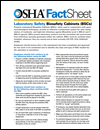Biosafety Cabinets
Annual Certification
Biosafety cabinets, laminar flow hoods, and other HEPA filtered equipment must be certification annually. When cabinets are coming due for recertification, EHS will notify the contact person on record for each cabinet and the associated department chairperson.
To schedule recertification, contact scheduling@qairservice.com.
Contact Purchasing to obtain a PO or use your Purchasing card for payment.
Disinfect the cabinet, fill out and attach an Equipment Release Form (PDF) prior to the appointment. If you have questions about disinfecting contact EHS. The certifier will not be able to service the equipment without the form attached.
Safe Use
 OSHA FactSheet Laboratory Safety Biosafety Cabinets (PDF)
OSHA FactSheet Laboratory Safety Biosafety Cabinets (PDF)
How to safely use a biosafety cabinet used with permission from Arizona State University.
ABSA 2018 Myth Busters: Does Heat Really Affect Protection?
Recommended Practices
Avoid airflow disruption:
- Do not block the air grills with equipment, waste, materials, etc.
- Minimize movement through the front access opening.
- Minimize room traffic in front of the cabinet.
- Open flames are prohibited as according to manufacturer recommendations.
- Do not overload the cabinet. Only load those materials that are necessary for the procedure.
Use safety practices:
- UV lights are not recommended, these lights can cause serious eye and skin injury. Do not depend on them for disinfection alone. Cleaning frequently and logging hours of use is required. The UV will only disinfect flat surfaces in which it comes into direct contact.
- Open flame is prohibited especially when alcohol is present.
- Purge airborne contaminants by running cabinet before work and after.
Keep it clean:
- Work from clean end of cabinet to dirty. Perform contaminated material work in the rear of the work area.
- Disinfect your cabinet as well as items used within cabinet, before and after use with approved disinfectant.
Keep it maintained:
- Certify it annually, after being relocated or after all major repairs including filter replacement. This is the only way to detect leaks that can be a contamination risk for your materials and exposure risk for you.
- Disinfect thoroughly under grill and tray, inner walls as far up as you can reach including the window sash.
For additional information and questions regarding biological safety cabinets please contact the EHS Biosafety Team at 355-0153.

